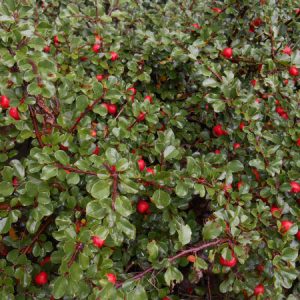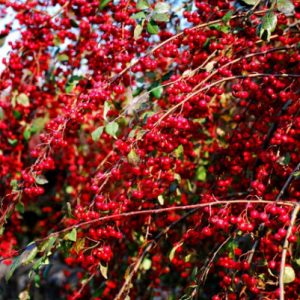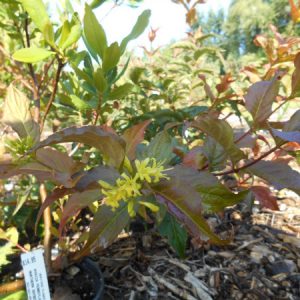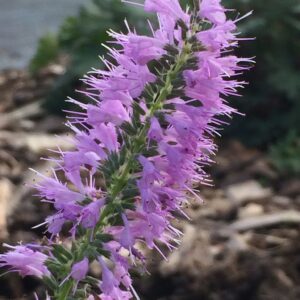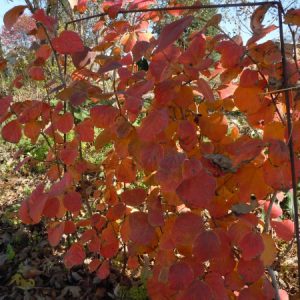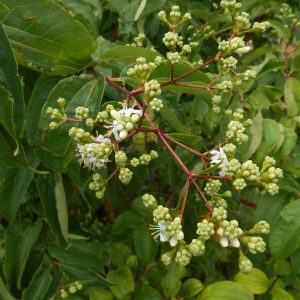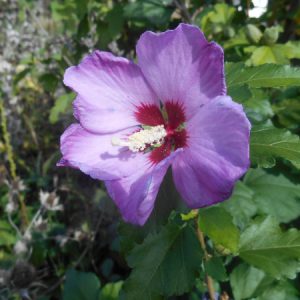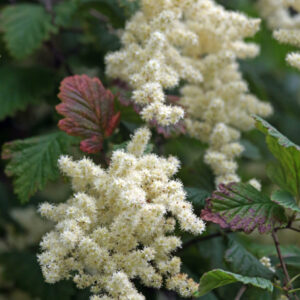Woody Ornamentals
Showing 17–24 of 46 results
-
Cotoneaster apiculatus Cranberry cotoneaster Z 5-7
White flowers followed by bright red berries lasting all winter. Glossy, leathery foliage tinges bronze in fall.
OUT OF STOCK
White flowers followed by bright red berries lasting all winter. Glossy, leathery foliage tinges bronze in fall.
Size: 3’ x 7’
Care: Sun in moist well-drained soil. Blooms on new wood so can prune in spring. Pruning promotes bushy plant and increased flowering.
Native: SW ChinaCollected by E.H.Wilson before 1916 who described it as “forming neat mounds . . . straddled with scarlet berries in the fall and winter.”
**LISTED AS OUT OF STOCK BECAUSE WE DO NOT SHIP THIS ITEM. IT IS AVAILABLE FOR PURCHASE AT OUR RETAIL LOCATION.
-
Cotoneaster multiflorus Showy cotoneaster, Many-flowered cotoneaster Z 4-8
Descriptively named “many-flowered” this specimen, fountain-shaped shrub with arching branches covered in spring with white flowers of five oval petals blooming all along the branches. In fall yellow leaves set off spectacular apple-red fruit replace each flower, all along the branches.
OUT OF STOCK
Descriptively named “many-flowered” this specimen, fountain-shaped shrub with arching branches covered in spring with white flowers of five oval petals blooming all along the branches. In fall yellow leaves set off spectacular apple-red fruit replace each flower, all along the branches.
Size: 10’ x 10’
Care: sun to part shade in well-drained to moist well-drained soil
Native: Western China.In China called shui xun zi. Collected by 1830.
-
Diervilla lonicera Northern bush honeysuckle Z 3-7
Lemon yellow flowers on this short shrub June to August. In fall its foliage turns dark red for the final fireworks’ display. Great shrub for tough, dry shady areas.
Lemon yellow flowers on this short shrub June to August. In fall its foliage turns dark red for the final fireworks’ display.
Size: 3’ x 3’ spreading
Care: sun to part shade in well-drained soil, drought tolerant
Native: Eastern half of US & Canada, Wisconsin native.
Wildlife Value: nectar source for Bumblebees. Birds make nests from the branches and eat the fruitsUsed medicinally by numerous Native Americans – Algonquin, Chippewa, Cree, Iroquois, Menominee, Meskwaki, Ojibwa and Potawatomi. Used as remedy for sore eyes, diuretic, “old men who cannot retain urine,” constipation, stomach pain, increase breast milk, to “spoiled babies with adulterous mother,” STD’s and vertigo. Dr. N. Dierville, a surgeon, carried this to France from Canada (then Acadia) in 1699. Botanist to France’s king, Louis XIV, Joseph Pitton de Tournefort (1656-1708) named this to honor Dierville
**LISTED AS OUT OF STOCK BECAUSE WE DO NOT SHIP THIS ITEM. IT IS AVAILABLE FOR PURCHASE AT OUR RETAIL LOCATION.
-
Elsholtzia stauntonii mu xiang ru in China, Chinese mint Z 4-8
Tube-shaped purple flowers ascend in spires in fall on this subshrub that dies back in colder areas to regrow from the roots in spring. Valuable for its late bloom and fragrant foliage.
Tube-shaped purple flowers ascend in spires in fall on this subshrub that dies back in colder areas to regrow from the roots in spring. Valuable for its late bloom and fragrant foliage.
Size: 3-5’ x 3-5'
Care: sun in moist well-drained to well-drained soil
Native: hills, mountainsides and river banks in Gansu, Hebei, Henan, Shaanxi, Shanxi, China
Wildlife Value: nectar for bees late in seasonChinese mint shrub was collected in 1790’s during England’s Macartney expedition to China. Named for Prussian horticulturist, author, and Doctor Johann Sigismund Elsholtz (1623-1688) and Sir George Staunton, baronet (1737 – 1801), secretary of the expedition. He authored the three-volume report of the expedition and collected plants including this. An Authentic Account of an Embassy from the King of Great Britain to the Emperor of China.
-
Fothergilla gardenii Dwarf fothergilla Z 5-9
Honey-scented ivory bottlebrushes, made up of long stamens, 2” tall in spring, leaves turn jewel toned red, purple & orange in fall.
Honey-scented ivory bottlebrushes, made up of long stamens, 2” tall in spring, leaves turn jewel toned red, purple & orange in fall.
Size: 2-3’ x 2-6’
Care: sun to part shade in moist well-drained, acidic soil. Pruning not recommended.
Native: NC south to MS & west to TN
Awards: Missouri Botanic Garden Award of Merit, Great Plant Pick Award from Elisabeth Carey Miller Botanical GardenCollected before 1750’s by John Bartram and offered for sale in Bartram Garden’s 1783 Broadside, America’s 1st plant catalog. Genus named to honor Dr. John Fothergill (1712-1781) avid English plant collector & friend of Peter Collinson. And species named to honor Dr. Alexander Garden, (1730-1791) a colonial Scotsman who lived in the Carolinas.
-
Heptacodium miconioides Seven son flower Z 5-9
Fragrant white flowers August –September then large clusters of burgundy calyces surround the fruit capsules as showy as the flowers on this large shrub or small tree. Ornamental tan and red-brown peeling bark and glossy heart-shaped leaves.
Fragrant white flowers August–September then in October clusters of burgundy-red calyces surround the fruit capsules as showy as the flowers on this large shrub or small tree. Ornamental tan and red-brown peeling bark and glossy heart-shaped leaves. “Avant Gardener” newsletter September 2011, calls it the “two-bloom tree,” saying, “more and more praise is being lavished on a rare late-flowering shrub/tree … even more showy (than the panicles of fragrant white flowers) is its ‘second bloom’, consisting of red-purple calyxes which remain after the flowers fall…well into October.”
Size: 15’ x 10-12’
Care: sun in moist to moist well-drained soil, drought tolerant. Prune in late winter to make it bushy, maintain shape or reduce size, if you wish.
Native: China
Wildlife Value: Attracts butterflies & bees, Deer resistant. Salt tolerant.
Awards: 2011 Great Plants Shrub of the Year; 2008 Plant Select®; Cary Award Distinctive Plants for New England & Pennsylvania Horticultural Society Gold, Missouri Botanical Garden Plant of MeritHepta means seven because each inflorescence has 7 flowers, and codium means flower. Collected initially by E H Wilson in 1907 at about 3000 feet in Hupeh Province. Rare in its native China.
-
Hibiscus syriacus Rose of Sharon Z 5-9
Bodacious blooms of white and magenta July to September
Bodacious blooms of white and magenta July to September
Can not ship to: Georgia, Maryland, Mississippi, Virginia and West Virginia
Size: 8-10’ x 6-8’
Care: sun to part shade in most any soil.
Native: China and India
Wildlife Value: pollinated by hummingbirds, bees and butterfliesGrown in the Eichstätt Garden, the garden of Johann Konrad von Gemmingen, prince bishop of Eichstätt in Bavaria, c. 1600. Grown by Tradescant the Elder in England – 1634. Chinese used the flowers and leaves to make tea. George Washington planted these near the serpentine bowling alley at Mount Vernon. Grown at America’s 1st botanic garden, Elgin Botanic Garden 1811.
**LISTED AS OUT OF STOCK BECAUSE WE DO NOT SHIP THIS ITEM. IT IS AVAILABLE FOR PURCHASE AT OUR RETAIL LOCATION.
-
Holodiscus discolor Creambush, Ocean spray Z 5-10
Multistemmed shrub with dense, elegant pyramidal clusters of arching cream-colored flowers in early to mid summer. Leaves tint red in fall.
OUT OF STOCK
Multi-stemmed shrub with dense, elegant pyramidal clusters of arching cream-colored flowers in early to mid-summer. Leaves tint red in fall.
Size: 4-8’ x 8’
Care: sun to part shade in moist to moist well-drained soil
Native: Montana to Colorado west to the Pacific.
Wildlife Value: nectar for hummingbirds, food for butterfly caterpillars, bird habitat.Hard and durable wood was used to make digging sticks, spears, harpoon shafts, bows, and arrows by nearly all coastal Native groups. A few used the wood to make sticks to barbeque salmon, fish hooks, needles for weaving and knitting, Pegs were made to use like nails. Others made wood intoarmor plating and canoe paddles.
A few Natives made an infusion of boiled fruit to cure diarrhea, measles, chickenpox and as a blood tonic. Collected by Meriwether Lewis in today’s Idaho on the Clearwater River, May 29, 1806 en route back east on the Lewis and Clark Expedition.

